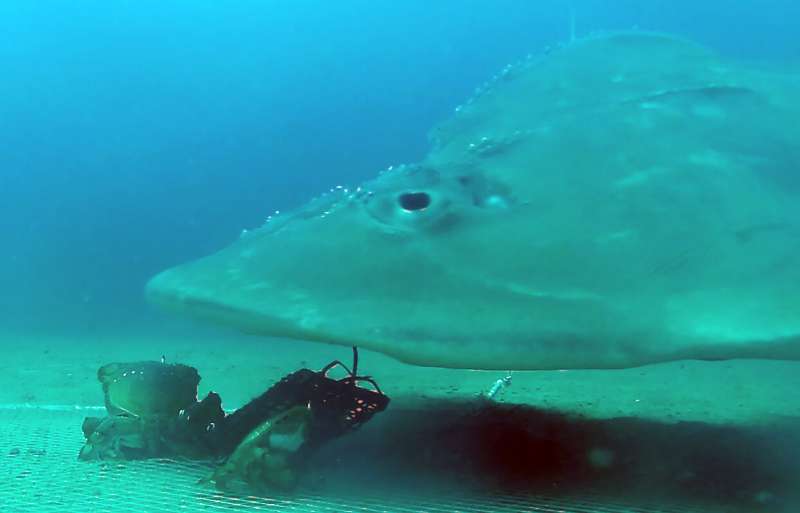This article has been reviewed according to Science X's editorial process and policies. Editors have highlighted the following attributes while ensuring the content's credibility:
fact-checked
peer-reviewed publication
proofread
Aggressive shrimp and surprising predators make life tough for spanner crabs

For years, fishers have suspected sharks of stealing their spanner crab catch. Now a University of the Sunshine Coast study has cleared sharks and instead uncovered three unexpected culprits taking a bite out of Australia's commercial crab industry.
UniSC researchers teamed up with the Department of Agriculture and Fisheries and commercial fishers to understand what was going on below the water and were surprised to discover two of the world's most endangered marine rays were the only offenders preying on spanner crabs once they were in the traps.
The critically endangered bowmouth guitarfish (Rhina ancylostoma) and wedgefish (Rhynchobatus) are rarely observed in waters off Queensland's South East, which produce 80% of the total catch of Australia's spanner crab fishery.
The study, published today in Fisheries Research, also found the vibrant red crustaceans are dealing with another previously unknown menace while in the traps—the mantis shrimp—who uses its set of raptorial-like arms to deliver extremely powerful blows at close range to the crabs.
UniSC marine biologist Dr. Bonnie Holmes said the study used underwater cameras on commercial fishing gear to provide fascinating insights into why fishers retrieving their catch were finding spanner crabs with unexplained injuries, including missing limbs.
"Our research highlights for the first time potentially competitive and aggressive interactions between mantis shrimps and spanner crabs, resulting in a loss of the catch and an increase in the number of harvested crabs being discarded due to damage," Dr. Holmes said.
"We recorded many instances of mantis shrimps hitting the crabs with such force that their shells would shatter and create large holes. Many more crabs would come up on the dillies with injuries and need to be thrown back."
Understandably, the crabs also tend to make themselves scarce when shrimps are nearby which also reduced the catch. Crabs would either not enter the dilly or would quickly scurry away from the bait bag and dilly once a mantis shrimp appeared.
Spanner crabs are a renowned delicacy, exported live all over the world after being commercially caught in waters stretching from central Queensland to the New South Wales border. Australia's spanner crab fishery is the largest in the world, part of a multi-million-dollar industry worth up to $12.9 million per annum.
"This study is one of the first in Australia to identify the species and drivers involved in spanner crab depredation and investigate the extent of these losses, to provide insights into ways these events can be mitigated and managed," Dr. Holmes said.
"It is helping to fill a gap in knowledge of Australia's spanner crab fishery and identify changes in fishing practices that could assist with the management and sustainability of the industry."
Dr. Holmes was the lead supervisor of the study by UniSC Fraser Coast Animal Ecology first-class Honors graduate Jackson Milburn. Over a six month period, Mr. Milburn deployed high-resolution cameras on 178 baited open-style flat mesh dilly nets on commercial fishing vessels in waters off Bundaberg, Tin Can Bay and Fraser Coast.
Overall, the study found rates of depredation in the fishery were low, with just under 4% of harvestable crabs being taken or damaged while in the fishing gear.
"The only offenders caught on film preying on the crabs were the bowmouth guitarfish and wedgefish. Each time they attacked a dilly net, they stole just over half of the catch," Mr. Milburn said.
What of the former prime suspects, the sharks?
Mr. Milburn said sharks were found to be more interested in the pilchards used as bait, rather than the crabs themselves, despite the crustaceans making up part of their diet.
"We filmed tiger sharks ignoring the crabs in the nets but removing the bait bags. Although not caught on camera, 60 dillies were significantly damaged when they were retrieved, and we suspect tiger sharks are the culprits here due to the ferocity of their attempts to dislodge the bait."
Researchers say there are several key learnings, including inefficiencies that lead to reduced catch rates in the Queensland fishery, that warrant further study.
"We observed the direct loss of crabs in the catch of commercial operators due to gear deployment inefficiencies was almost 37%. This far outweighs the loss of crabs due to depredation (around 4%) or mantis shrimp interactions," Mr. Milburn said.
"Most notably we found that the potential gain in harvestable crabs could have been increased significantly by reducing the amount of time the nets are underwater."
Dr. Holmes said the discovery that two critically endangered batoid species were the sole drivers of raids on spanner crab nets in the study region presented unique challenges.
"We need to balance protecting fisheries catches from predator attacks with the ecological risk of interacting with threatened species," she said.
"However, given this study occurred over a restricted area of the fishery and time period, further research is required to identify the extent of interactions, which may provide a clearer understanding of how interactions may be mitigated."
More information: J.R. Milburn et al, Depredation of spanner crabs (Ranina ranina) by endangered batoids off the east coast of Australia, Fisheries Research (2023). DOI: 10.1016/j.fishres.2023.106619
Journal information: Fisheries Research
Provided by University of the Sunshine Coast



















